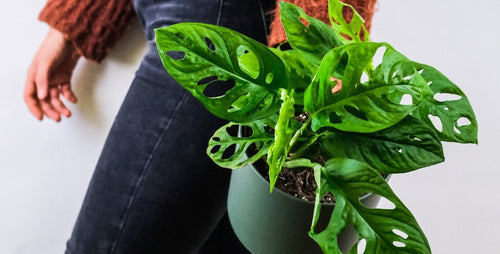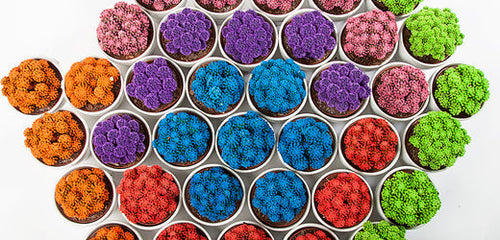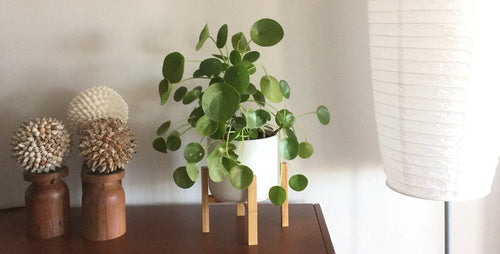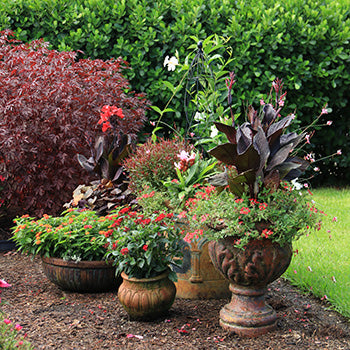By Karen Weir-Jimerson
Your moisture-loving houseplants need special care indoors during the long drying months of winter. Here are 10 ways to keep
your plants healthy, in top shape, and able to survive the insults of the dry air of winter.

1. Watch overwatering
Although it seems that the dry air of winter requires more water for plants, it's
way too easy to over do it. In fact, most houseplant deaths are caused by overwatering. The best rule of thumb for
watering is to test the soil for moisture. You can do this by digging your index finger about an inch down into the
container’s soil. If it feels moist, don’t water. Only add moisture if the soil about 1 inch deep is dry.
Dig in for tips to successfully
water your plants.
2. Add humidity
Most houseplants are indigenous from moist, tropical locations. Think jungles. Think humidity. Houseplants literally drink in and love humidity. But your home in winter becomes a desert with forced air heat and fireplaces blazing. Give your houseplants the gift of humidity by placing them near a humidifier or in your shower. (Get more on plants that excel in bathrooms.) You can create a low-tech humidifier by simply placing potted plants on a tray filled with pebbles and water. The evaporating water raises the humidity around the plants naturally (and silently!).
3. Group plants together
The old adage “there’s strength in numbers” applies to plants in winter. An easy and clever way to heighten humidity for your houseplants is simply to group them together. It’s like creating a mini ecosystem around the plants -- just like they are grouped growing together in a natural jungle setting. It’s a humidity forcefield. Here’s another benefit: When you group plants together with the same watering needs, it’s easier to keep everyone uniformly and successfully hydrated.

4. Supplement lighting
The shorter days of winter are hard on sun-loving houseplants. So adding grow
lights to your home may be an easy way to coddle your plants through the dark days of winter. These artificial lights
can be used to light a large area of plants or are available for individual plants.
Dig in for more about the lighting requirements of
indoor plants.
5. Check for pests
It may seem unlikely that you would get a pest infestation on your plants in winter, but that’s exactly the time and place that tiny, sap-sucking pests will appear. Do a proactive leaf search every time you water. Turn the plant leaves over and inspect their undersides. Pests, such as aphids and scale, often first appear on the bottom of the leaves and at the base of stems. Do think your plants might have spider mites? Here’s how to identify and treat them.
6. Position plants away from drafts
Where you keep your houseplants in the summer and where they
live indoors in the winter may need to be very different. No plant does well if exposed to cold drafts, so position
plants away from doors that may deliver occasional blasts of frigid air. The same goes for plants that sit in windows;
if the interior of the window gets too cold, it can affect your plant’s growth. Even leaves that touch cold glass may be
affected. Blasts of hot air are equally damaging. You may need to move plants off mantles during holiday fireplace
blazes. Plants sitting directly underneath warm air registers may dry out more quickly.

7. Prune to shape up
Shaping up leggy plants is a great way to revive their look in winter. Some plants look best
when shaped a certain way. Bonsai, for example, are specifically grown so you can shape them the way you please. If an
errant limb destroys the visual aesthetic, it's totally fine. Clip it off. Permission granted! Simply snip off branches
or leaves that are the culprits, thereby reshaping the plant.
Dig in for tips for raising tropical bonsai
indoors.
8. Trim off the dead
Plants with dead leaves look bad, so
trimming off these leaves at the base of the stem makes a tired plant look immediately revived. Use clean sharp scissors
or pruners.
Here are 10 more
things to know as a new houseplant parent.

9. Turn plants to avoid phototropism
You may notice plants growing toward the windows
in your home. This is called phototropism, which is how a plant responds to light. If your plant isn’t getting enough
light, it will reach toward the light, attempting to better position itself. Pretty smart. When a plant grows toward the
light, it is called positive phototropism. Plants can also grow away from light, which is called negative phototropism.
If your plant seems to be leaning one way or another, turn it every week or so to help it maintain its shape. Which
leads to the next tip...
10. Adjust placement placement to provide better light
If yourplant is showing signs of light deprivation (such as yellowing leaves or dramatic phototropism), look for a new spot for
it to ride out the winter. Research the light needs of the species and place it in the right light.
Here are 5 of the
easiest-to-grow houseplants.
Dig in:
Houseplant Basics

















